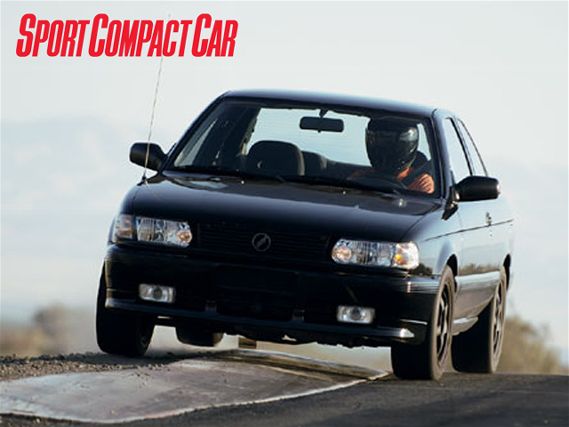 | Project Nissan Sentra SE-R - Tech
| Project Nissan Sentra SE-R - Tech
When I first looked at the brake caliper mounting brackets, I honestly thought Jared Holstein had whittled the damn things out of an old chocolate bar. Using candy as a structural component of your car's most fundamental safety system is probably a bad idea, but I installed them anyway. Such is the sex appeal of four-piston calipers.
The brakes were an early Fastbrakes kit that paired Wilwood calipers with an 11.8-inch rotor on an aluminum mounting hat. The brackets turned out to be steel with a chocolaty coating of rusty scale and CV joint grease. They also happened to have just been outlawed in NASA's SE-R Cup series. That made the NX2000 brakes on my SE-R the stoppers of choice and rendered the Wilwoods worthless for Jared's race car which, ironically, was virtually worthless itself.
So we swapped and I strutted out into the street with my fancy new stoppers only to have the pedal sink nearly to the floor in my first panicked approach to a stop sign. Turns out the NX2000 brake system I had just swapped out had a 7/8-inch master cylinder, which is barely big enough for its 54mm single-piston calipers. Pushing four 34mm pistons takes about 60 percent more fluid, and that's just enough so that the master cylinder will bottom out before the brakes do anything decisive.
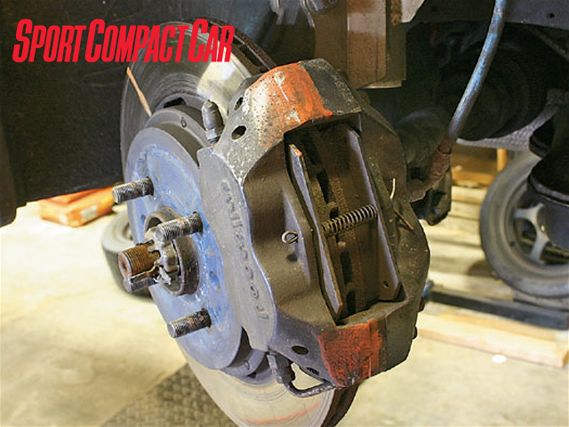 | The original Fastbrakes kit used 11.8-inch rotors, which don't quite fit with our new 15-inch Motegi Trak Lites.
| The original Fastbrakes kit used 11.8-inch rotors, which don't quite fit with our new 15-inch Motegi Trak Lites.
At the time, Jared and I shared a gritty industrial rental in a rough, third-world corner of Orange County. In truth, our 'race shop' was nothing more than 1200 square feet of filth and disarray, but in it we could find a solution to nearly any automotive problem. Lying on its side, jammed between three quarters of a Datsun 510 and a set of buckets Jared used as toolboxes, I had the skeletal remains of an old experiment. The floorpan, firewall, and several boxes of parts that had once been the 14.3-second B15 Sentra we used in the SCC Technical Assistance Program.
In one of those boxes was an almost-new 15/16-inch B15 master cylinder, just big enough to solve the problem. Voila, suddenly, I had a firm pedal and a car that locked its front brakes at the mere suggestion of deceleration.
Apparently, the Wilwoods offered up a fair bit more brake torque than the NX2000 stoppers they replaced, suddenly throwing off brake balance. Again, the rotting carcass of the world's fastest potato offered up the solution, donating its rear brakes to the cause. Both the B13 and B15 use the same size rear caliper, so the clamping force on the rotor should be the same, but the B15's larger rotor will make more torque from that clamping force, hopefully fixing the front-to-rear brake balance.
This was not so simple a swap, though. The B15's wheels have a 4x114.3 bolt pattern while the B13 used 4x100. That meant I had to re-drill the B15 rotors, or, more accurately, file each hole 7.15mm by hand.
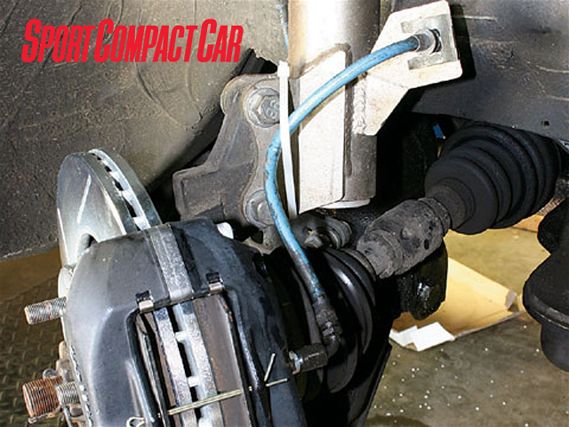 | The first time you test-fit the wheels, make sure the brake line can't touch the wheel under any condition.
| The first time you test-fit the wheels, make sure the brake line can't touch the wheel under any condition.
The B15's beam axle rear suspension also puts the calipers on the rear of the rotor, while the B13s are on the front. They're still interchangeable, but you have to swap them left to right so the bleed screw stays on top when the calipers flip to the front. Oh, and the mounting bracket for the parking brake cable is in absolutely the wrong place and there isn't a damn thing you can do about it, except for leaving the car in gear when you park. Surprisingly, this assortment of brake junk worked well enough that I was willing, in my laziness, to forgo a functional parking brake for several years. It was only as I installed the featherweight 15-inch Motegi Trak Lite wheels, introduced in the last installment, that a real solution was needed.
Turns out the brakes didn't fit inside the new wheels. Desperate to make the photo shoot, I made them fit by spacing the wheels out 5mm and slightly re-profiling the right-hand caliper with a file. I don't recommend this solution.
Before taking on the B15 SE-R at the track, we'd need the wheels and brakes to get along a little better. SE-R Cup rules have changed since this combination was first cobbled together, and Fastbrakes Wilwoods are again the brake of choice. But the new brakes fit inside 15-inch wheels.
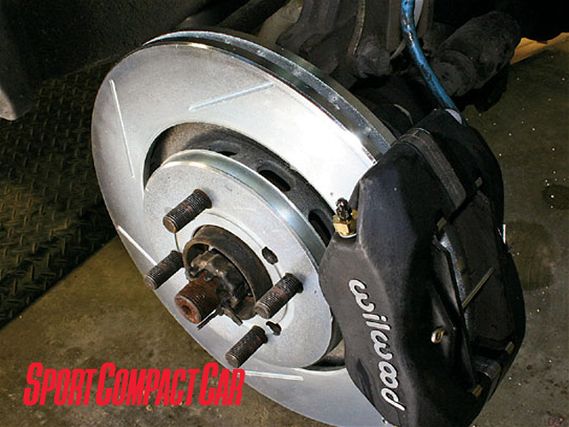 | The readily-available Corrado rotor used in the new Fastbrakes kit lowers replacement cost and moves the caliper in just under half an inch compared to the old 11.8-inch rotor, just enough to squeeze it into a 15-inch wheel.
| The readily-available Corrado rotor used in the new Fastbrakes kit lowers replacement cost and moves the caliper in just under half an inch compared to the old 11.8-inch rotor, just enough to squeeze it into a 15-inch wheel.
The new kit uses a slightly smaller 11-inch Volkswagen Corrado brake rotor, which adds a few pounds, but saves replacement cost and shrinks the overall package just enough. The new mounting brackets are also billet aluminum instead of chocolate and even the Wilwood caliper is an updated design.
There are several wrong ways to install the new billet mounting brackets, all of which we tested. To save time, install the rotor first and hold it snug against the hub with two lug nuts. Then take the caliper, without brake pads, and install it with the mounting bracket oriented however you think it goes. Snug the bolts down by hand, making sure everything fits flush, and see if the rotor is centered in the caliper. If not, you guessed wrong. Repeat as necessary until you stop screwing things up.
Fastbrakes discovered the same balance problem we did and suggest a similar, but clearly better, solution. They recommend 1989-94 Nissan Maxima rear calipers which are designed to mount on the front of the rotors, just like the B13. The stock SE-R parking brake cables hook right up. If you can find NX2000 ABS rear rotors, they're the same as the B15 rotors we used, but already have the B13 4x100 bolt pattern.
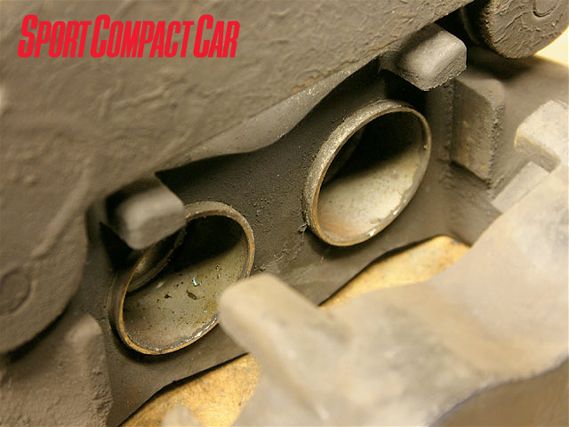 | A common criticism of Wilwood calipers is they don't have dust shields to protect their piston seals. But in our experience, such seals are seldom necessary.
| A common criticism of Wilwood calipers is they don't have dust shields to protect their piston seals. But in our experience, such seals are seldom necessary.
Confident we were now installing a fully sorted kit that would need no further adjustment, we naturally installed the brakes the night before our big track battle. The plan was to use the Ferodo DS2500 brake pads from the old Fastbrakes kit, but the first attempt to stop with the new brakes was as terrifying as the first time with Jared's. This time initial bite was great, but mashing the middle pedal did nothing dramatic, just gently slowed the car.
Close inspection showed the pads weren't touching the inner or outer ends of the rotor surface. The old rotors were severely worn-taking on a concave contour-and the pads had worn into a complementary convex shape. Pressed against the flat new rotors, only the middle of the pad made contact. We swapped in the brand-new Hawk HPS pads that come with the Fastbrakes kit, did a few hot laps around the block to bed them in, and thought the problem was solved.
At the track, things still didn't quite work. Though firm and responsive at street speeds, heavy braking at high speed made the pedal soft and unresponsive, causing the rear brakes to lock first. The HPS pad compound is engineered for street use and doesn't have enough bite at high temperatures.
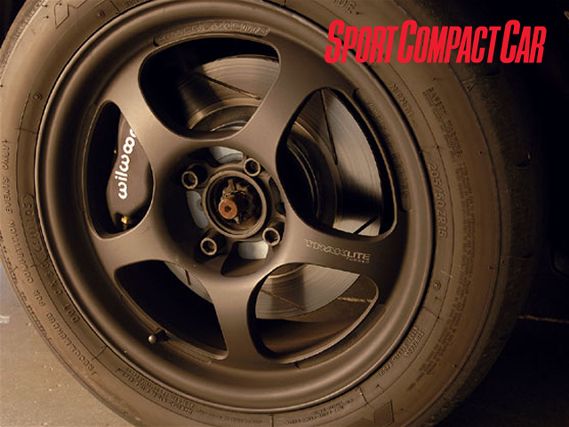 | Project Nissan Sentra SE-R - Tech
| Project Nissan Sentra SE-R - Tech
As high-speed braking panic sets in, you push the pedal harder, which just causes the calipers to flex. Wilwood calipers are lighter and less expensive than Stoptechs or Brembos, but the tradeoff is a less rigid shape-something that became clear as we tried to get the wooden pads to bite.
These brakes work quite well on SE-R Cup cars, but only with better brake pads. It's also possible that our Maxima rear brakes, though a perfect match for the old 11.8-inch ones, are too strong to balance with the new 11-inch kit.
Tom Paule's SE-R cup car, for example, uses this Fastbrakes kit in the same Motegi Trak Lite wheels. Paule uses Hawk Blue brake pads up front, though, and smaller SE-R brakes with cheap Pep Boys pads in the back. These grippier pads mean less fluid pressure, therefore less caliper flex, for the same front brake torque. The smaller rear brakes, with crappy pads, make the brake system more front-biased, something ours needs a bit more of.
So learning from our missteps, get the Fastbrakes kit, throw the HPS pads in the trunk to use as your get-home pads if you burn through a set at the track, and buy something more aggressive to actually use. If it's a street car, I still think the Ferodo DS2500s should work well. Leave your stock rear brakes in place, get braided steel lines all round, and use a 15/16-inch master cylinder from a B15 Sentra or mid-90s Altima.
